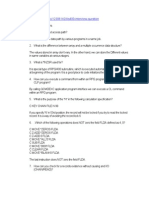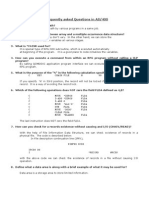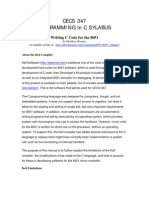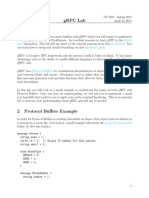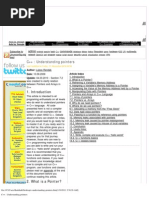I RPG Pointers PDF
I RPG Pointers PDF
Uploaded by
bhushan patilCopyright:
Available Formats
I RPG Pointers PDF
I RPG Pointers PDF
Uploaded by
bhushan patilOriginal Title
Copyright
Available Formats
Share this document
Did you find this document useful?
Is this content inappropriate?
Copyright:
Available Formats
I RPG Pointers PDF
I RPG Pointers PDF
Uploaded by
bhushan patilCopyright:
Available Formats
Working with pointers in ILE RPG
Practical usages on MQ with large-length data handling in ILE RPG
Yukihiro Minote (yminote@jp.ibm.com) 20 June 2013
AITS
IBM Japan
In today's business environment, demand for sending or receiving large data within IT systems
is constantly growing and IBM i is no exception to that. To handle large data, IBM® Integrated
Language Environment® (ILE) RPG can use a pointer function. This article describes the
pointer concept, data segmentation method and how to use a pointer within ILE RPG. The
MQGET application programming interface (API) sample code is used for our modification
sample.
RPG and large message data
The RPG language is at the heart of IBM i. There can hardly be any IBM i application developer
who has never used it for building their applications. Accessing data through data description
specifications (DDS) file, such as a physical file, is an efficient way to get data easily from a
programming point of view. This is a concept that is well considered for developing business
applications quickly.
For a long time, user data that RPG has handled were not long because of the DDS I/O size
limitation (for example, the length of a physical file record must be 32766 bytes or smaller).
In V5R4 RPG, the maximum message length for a fixed-length character field is 65535, but
beyond V6R1, the size changed from 65535 to 16773104. Because the I/O size is smaller than
RPG limitation, we need not care about the character length issue in our programming cycle.
On the other hand, when we look into our business transactions today, there are many long
message lengths data, such as XML. We see business data over 64 KB message length, being
exchanged and processed. In the real world, RPG does not ignore or isolate this game change.
Even though today's RPG has already extended their capacity for large data, there are much
larger data existing on the customer's production environment. For example, the IBM WebSphere
MQ product has been used for exchanging information between systems. RPG can also handle
these data through MQ common APIs, such as MQGET. You can increase the size of the
MaxMsgLength attribute up to 100 MB on all WebSphere MQ systems at V6 or later.
© Copyright IBM Corporation 2013 Trademarks
Working with pointers in ILE RPG Page 1 of 7
developerWorks® ibm.com/developerWorks/
How can we handle these large message length data within RPG? The most common way is to
use application segmentation. Figure 1 shows how to do that. In this article, we will discuss pointer
in ILE RPG. Then, we will talk about pointer operation, overlaying data with a pointer-based field,
and finally the data segmentation method with ILE RPG.
Figure 1. Data segmentation overview
Using the application segmentation for large message length data
This section explains segmentation and the concept of pointer that is used for dividing data easily.
The definition for the word segmentation itself, is the act of dividing something into smaller parts,
or the state of being divided. In this article, segmentation means the program logic of dividing large
message length data into chunks of smaller message length data so that they can be handled by
a program variable. We will divide large data into 64 KB data chunks and process with a normal
RPG code logic. To do this, we use the pointer operation. What is a pointer? Which operation code
should we specify in RPG and how do we write a code using it?
The pointer in ILE RPG
The concept of pointer is not a state-of-the-art technology. Many computer languages (such as C)
have the same concept for handling data efficiently. Generally, a pointer is a useful piece of advice
or information that helps you do or understand something. In computer terminology, a pointer is a
field that contains a memory address.
Multiple occurrence data structure is a good sample of pointer. The occurrence of the database is
based on an offset of the address in the data structure.
Let's take a look at the pointers in ILE RPG.
Working with pointers in ILE RPG Page 2 of 7
ibm.com/developerWorks/ developerWorks®
First, you define pointer data types '*' in D spec. You also need to define fields, arrays or data
structures whose positioning in memory is based on the value of the pointer with the Based
keyword. See Figure 2.
Figure 2. Pointer definition in D spec
With this definition, we can map the data to the location that the pointer variable addresses. This
means that any message length of data can be divided into smaller chunks. Figure 3 illustrates the
concept of pointer address operation.
Figure 3. Moving the pointer address
A pointer can show any address of the data. A field that is based on this pointer can refer or
overlay the data. We can change the value of a pointer by adding or subtracting that value. With
these operations, you will see overlaying data.
Now, we understand what a pointer is in ILE RPG programming. Next, we must understand how to
get the pointer value within an ILE RPG code.
Built-in function %ADDR
In ILE RPG, the %ADDR built-in function is used for getting the address of a pointer. From an
ILE programming model point of view, variable fields are referenced for processing data. So a
variable's pointer value is needed when coding a pointer operation. Figure 4 shows you how to use
this built-in-function.
Working with pointers in ILE RPG Page 3 of 7
developerWorks® ibm.com/developerWorks/
Figure 4. Usage of the built-in function, %ADDR
In this code snippet, variable p is defined as a type pointer. The data structure, TestDS, is also
declared. It contains two text fields. The first one is initialized as static text '1234' and second one
as '5678'. The variable field, p, is initialized as the result of %Addr(Text1). This means that the field
p retrieves the pointer value of the Text1 field, which is '1234'. This is because the variable field is
based on the pointer variable p. Next, the Eval operation 'p= %Addr(Text2)' changes the values of
pointer p. Now the value of pointer p is equal to the value of the Text2 pointer which is '5678'.
So far we have gone through ILE RPG pointer concept, definition procedure itself and its operand
in ILE RPG codes. To put these pieces together more clearly, I will give you a practical sample
program code using the MQ API, MQGET, that can handle pointers.
Sample code MQGET with pointer
The MQGET function call is used for retrieving data from the message queue. From an ILE RPG
point of view, MQGET syntax is as follows.
MQGET(HCONN, HOBJ, MSGDSC, GMO, BUFLEN, BUFFER, DATLEN,
CMPCOD, REASON)
And, its prototype definition for the call is:
C*..1....:....2....:....3....:....4....:....5....:....6....:....7..
C CALLP MQGET(HCONN : HOBJ : MSGDSC : MO :
C BUFLEN : BUFFER : DATLEN :
C CMPCOD : REASON)
D*..1....:....2....:....3....:....4....:....5....:....6....:....7..
DMQGET PR EXTPROC('MQGET')
D* Connection handle
D HCONN 10I 0 VALUE
D* Object handle
D HOBJ 10I 0 VALUE
D* Message descriptor
D MSGDSC 364A
D* Options that control the action of MQGET
D GMO 112A
D* Length in bytes of the BUFFER area
D BUFLEN 10I 0 VALUE
D* Area to contain the message data
D BUFFER * VALUE
D* Length of the message
D DATLEN 10I 0
D* Completion code
D CMPCOD 10I 0
D* Reason code qualifying CMPCOD
D REASON 10I 0
Working with pointers in ILE RPG Page 4 of 7
ibm.com/developerWorks/ developerWorks®
You can see a parameter BUFFER that contains the whole message defined as type pointer. Also,
the IBM i MQ product provides a sample code for the ILE language. AMQ3GET4 is a sample code
for the MQGET function call with ILE RPG. This code is a good sample for understanding the ILE
RPG pointer operation.
In the original code, the BUFFER variable is defined as a 60-byte message length field as follows.
D BUFFER S 60
In this article, we extend that message length from 60 bytes to 32752 bytes.
D BUFFER S 32752
And, we add the following definitions to operate pointer values and addresses.
* Buffer pointer
D BUFPTR S * INZ (%ADDR(BUFFER))
*
*****ADD FOR TEST*****
D BUFF S 32752A BASED(P_BUFF)
D ARRAY S 32752A DIM(32)
D X S 10I 0
D Y S 10I 0
*****ADD FOR TEST*****
In the above code, the pointer variable BUFPTR is declared and initialized with a message length
of 32752 byte. And, the variable field, ARRAY is defined for dividing into small bytes within the ILE
RPG logic.
Here is an initialization logic for allocated pointer area.
***ADD FOR TEST***
/free
buflen = 32752* 32;
bufptr = %alloc(buflen);
for x = 0 to 31;
p_buff = bufptr + (x * %size(buff));
buff = *blanks;
endfor;
/end-free
***ADD FOR TEST***
The variable field buflen is 32752 bytes multiplied by 32, which calculates to a message length of
1048064 bytes.
The built-in %alloc is used for allocating memory area. Thus, this code allocates 5244288 bytes
long memory area and returns its pointer to the bufptr variable field. The %alloc function does
not initialize its allocated area. So, the user should take care of its initialization (the following line
shows how to do that). Each field, with a message length of 32752 bytes, is initialized as blank,
and therefore, the pointer moves to the next 32752 bytes, initializing again.
By 32 times of loop processing, the whole allocated memory area is initialized as *BLANK.
Working with pointers in ILE RPG Page 5 of 7
developerWorks® ibm.com/developerWorks/
The following code provides an example for retrieving data from the received message queue.
***ADD FOR TEST***
/free
for x = 0 to 31;
p_buff = bufptr + (x * %size(buff));
y = x + 1;
ARRAY(y) = buff;
endfor;
/end-free
***ADD FOR TEST***
As stated above, the MQGET function returns the message's pointer value. In our sample code, it
is represented by the variable field, BUFFER. So, with the above code, the message is retrieved in
chunks with 32752 bytes each. And then each message stores into the ARRAY field. With this ILE
RPG code, we can handle messages of over 1048064 bytes long. Here is the entire code for our
customization for the MQ sample AMQ3GET4.
Download code
References
• ILE RPG Language Reference > Definitions > Chapter 9. Data Types and Data Formats
Conclusion
This article described ILE RPG capability for large size data by using pointers.
Working with pointers in ILE RPG Page 6 of 7
ibm.com/developerWorks/ developerWorks®
About the author
Yukihiro Minote
Yukihiro Minote is a consulting IT specialist working for IBM Japan. He has 25 years
of experience in the IBM i environment. His areas of expertise include network (APPN
HPR and TCP/IP), security, and performance (in IBM DB2 for i and IBM WebSphere
Application Server on i).
© Copyright IBM Corporation 2013
(www.ibm.com/legal/copytrade.shtml)
Trademarks
(www.ibm.com/developerworks/ibm/trademarks/)
Working with pointers in ILE RPG Page 7 of 7
You might also like
- Grokking Simplicity: Taming complex software with functional thinkingFrom EverandGrokking Simplicity: Taming complex software with functional thinkingRating: 3.5 out of 5 stars3.5/5 (3)
- IBM AS/400 Interview QuestionDocument47 pagesIBM AS/400 Interview Questionmurugan100% (27)
- As 400 Interview QuestionsDocument50 pagesAs 400 Interview QuestionsMohan Kumar100% (2)
- WECCDocument12 pagesWECCCarlos MorenoNo ratings yet
- Peer-Graded Assignment - Week 4Document2 pagesPeer-Graded Assignment - Week 4ICT DA13No ratings yet
- Batch Best Practices PDFDocument55 pagesBatch Best Practices PDFMukesh BarnwalNo ratings yet
- I RPG Pointers PDFDocument6 pagesI RPG Pointers PDFAlfredo AlemanNo ratings yet
- UNIT-1 C ProgrammingDocument46 pagesUNIT-1 C ProgrammingMS ATHIRA S HICET IT FACULTYNo ratings yet
- Emb C - Unit I QBDocument23 pagesEmb C - Unit I QBANANTHI SNo ratings yet
- Chapter9 PointerDocument18 pagesChapter9 Pointerrishabh.emailNo ratings yet
- Unit-1 Basics of C' ProgrammingDocument52 pagesUnit-1 Basics of C' Programmingamuthavalli.cseNo ratings yet
- C ProgrammingDocument8 pagesC ProgrammingLigo PastiNo ratings yet
- Python & Modelbuilder Exercises May 6, 2010Document6 pagesPython & Modelbuilder Exercises May 6, 2010pace_sa100% (1)
- Prelim Module4 - BDocument11 pagesPrelim Module4 - BCelimen, John Renz C.No ratings yet
- C QuestionsDocument97 pagesC QuestionsVikas Yaragatti100% (1)
- C LanguageDocument119 pagesC LanguageSatyanarayan MedaNo ratings yet
- Saving Space With Pointer-Less CDocument9 pagesSaving Space With Pointer-Less CSougata DasNo ratings yet
- 2 Programming Using C++Document26 pages2 Programming Using C++Haider AliNo ratings yet
- Question Bank & Solutions-Module-1Document41 pagesQuestion Bank & Solutions-Module-1abcNo ratings yet
- As400 FaqDocument6 pagesAs400 FaqanupgiriNo ratings yet
- Advantages and Disadvantages of R ProgrammingDocument9 pagesAdvantages and Disadvantages of R Programmingpriyanshraisinghani123No ratings yet
- Keil C Programming TutorialDocument24 pagesKeil C Programming TutorialBhautik DaxiniNo ratings yet
- Morse Code Cnverter - PWPDocument9 pagesMorse Code Cnverter - PWPPranav GhomNo ratings yet
- C Programming and Data Structures - CS3353 - Important Questions With Answer - Unit 2 - C Programming Advanced FeaturesDocument6 pagesC Programming and Data Structures - CS3353 - Important Questions With Answer - Unit 2 - C Programming Advanced FeaturesROHISIVAMNo ratings yet
- C Programming LanguageDocument191 pagesC Programming LanguageKarthikeyan KNo ratings yet
- As/400 Interview QuestionDocument47 pagesAs/400 Interview Questionmurugan100% (20)
- Basic C QuestionsDocument48 pagesBasic C QuestionsWilliam McconnellNo ratings yet
- c++ Example ProgramsDocument23 pagesc++ Example ProgramsjayabrindhadNo ratings yet
- E3-E4 - Text - Chapter 2. IP CONCEPTSDocument11 pagesE3-E4 - Text - Chapter 2. IP CONCEPTSkishansingh35No ratings yet
- As 400 Faq'sDocument42 pagesAs 400 Faq'sChetan ChallaNo ratings yet
- BEST Interveriw Questions For AS400Document59 pagesBEST Interveriw Questions For AS400madhu sudhanNo ratings yet
- 02 Overview of C Programming LanguageDocument16 pages02 Overview of C Programming LanguageSuleman SaleemNo ratings yet
- 802 Lab6 S9Document8 pages802 Lab6 S9pro786skillsNo ratings yet
- First CPP AssignmentDocument8 pagesFirst CPP AssignmentAhtisham ArshadNo ratings yet
- AS400 Interview QuestionsDocument93 pagesAS400 Interview QuestionsDanny DanielNo ratings yet
- CH5 2Document24 pagesCH5 2sam negroNo ratings yet
- 4th Paper 1st PartDocument12 pages4th Paper 1st Partsgx.drNo ratings yet
- Atm Machine & Money Converter DocumentationDocument11 pagesAtm Machine & Money Converter Documentationabbas abbasNo ratings yet
- As 400 FaqsDocument73 pagesAs 400 FaqsVishnu Keerthi0% (1)
- As400 Q BankDocument38 pagesAs400 Q Bankhappygaur27No ratings yet
- Chapter 7: PointersDocument10 pagesChapter 7: PointersKrishnaiah NarvaNo ratings yet
- Variables: Variables Are Named Memory Locations Used To Store Values During Program ExecutionDocument58 pagesVariables: Variables Are Named Memory Locations Used To Store Values During Program ExecutiongopalNo ratings yet
- CECS 347 Programming in C Sylabus: Writing C Code For The 8051Document52 pagesCECS 347 Programming in C Sylabus: Writing C Code For The 8051BHUSHANNo ratings yet
- Omkar ProjectDocument31 pagesOmkar Projectjashuj885No ratings yet
- RPGLEDocument88 pagesRPGLEapi-385748367% (3)
- Dma& Usb Interfacing For Keyboard Using Cypress Psoc-5Document12 pagesDma& Usb Interfacing For Keyboard Using Cypress Psoc-5International Journal of Application or Innovation in Engineering & ManagementNo ratings yet
- FunctionDocument36 pagesFunctionriderallison489No ratings yet
- RPG Programming NotesDocument24 pagesRPG Programming NotesJuniorNo ratings yet
- Business Application ProgrammingDocument37 pagesBusiness Application Programmingpiyushnapit86No ratings yet
- QR-Code Generator: Phaisarn Sutheebanjard Wichian PremchaiswadiDocument4 pagesQR-Code Generator: Phaisarn Sutheebanjard Wichian PremchaiswadiPhaisarn SutheebanjardNo ratings yet
- Module4 Chapter2Document18 pagesModule4 Chapter2Sonia DeviNo ratings yet
- Dsa Assignment No 2 HAROON MALIK 19-EE-116Document12 pagesDsa Assignment No 2 HAROON MALIK 19-EE-116Haroon MalikNo ratings yet
- Keil C Programming TutorialDocument9 pagesKeil C Programming TutorialHådi MhNo ratings yet
- Mbed BK Ed2 CH 6Document18 pagesMbed BK Ed2 CH 6Pedro Augusto PeresNo ratings yet
- As 400 Interview QuestionDocument48 pagesAs 400 Interview QuestionpokirishivaaaNo ratings yet
- GRPC LabDocument7 pagesGRPC Labvaram10No ratings yet
- Apply OOPL SkillDocument109 pagesApply OOPL Skillgashu asmareNo ratings yet
- Snug04 Bromley Smith PaperDocument16 pagesSnug04 Bromley Smith PaperDheeraj SinglaNo ratings yet
- C Notes - Module1Document35 pagesC Notes - Module1Manish GuptaNo ratings yet
- C Programming for the PIC Microcontroller: Demystify Coding with Embedded ProgrammingFrom EverandC Programming for the PIC Microcontroller: Demystify Coding with Embedded ProgrammingNo ratings yet
- c++ & data structure practical file (bridge course)Document18 pagesc++ & data structure practical file (bridge course)zssdzwqpd9No ratings yet
- Data Management For Technical TablesDocument44 pagesData Management For Technical TablesfcanteriNo ratings yet
- Sr. Python EnginnerDocument2 pagesSr. Python EnginnerajjarapuNo ratings yet
- The Best Programming Advice I Ever GotDocument2 pagesThe Best Programming Advice I Ever GotLeslie MurphyNo ratings yet
- Devops Fundamentals Sample Course BookDocument33 pagesDevops Fundamentals Sample Course BookJohnny DohwNo ratings yet
- Mini Projects Using JavascriptDocument10 pagesMini Projects Using Javascript20COB153 PRABHAT SINGHNo ratings yet
- MKPL-2-SDLC SqaDocument15 pagesMKPL-2-SDLC Sqagrass32No ratings yet
- SUMITDocument1 pageSUMITsinghsumit6122No ratings yet
- Unit 3Document15 pagesUnit 3ankitarana0909No ratings yet
- #Manualtesting: Report To UsDocument8 pages#Manualtesting: Report To UsN NNo ratings yet
- MAC Learning Command Reference: This Chapter Describes Commands To Configure MAC Learning.Document8 pagesMAC Learning Command Reference: This Chapter Describes Commands To Configure MAC Learning.earespNo ratings yet
- MOVIETICKETBOOKINGDocument22 pagesMOVIETICKETBOOKINGnaman rawatNo ratings yet
- Software TestingDocument15 pagesSoftware Testingrupkumar8084No ratings yet
- G11-Etech-Ict-By Luffy G11 - Etech-Ict-By LuffyDocument38 pagesG11-Etech-Ict-By Luffy G11 - Etech-Ict-By LuffyRica Mae LopezNo ratings yet
- Spparks ManualDocument201 pagesSpparks ManualKaushik NagarajNo ratings yet
- OOP - I GTU Study Material Presentations Unit-3 02042022102826AMDocument58 pagesOOP - I GTU Study Material Presentations Unit-3 02042022102826AMdevNo ratings yet
- Generators & DecoratorsDocument16 pagesGenerators & DecoratorsSHAIK IRFANNo ratings yet
- C++ - Understanding PointersDocument17 pagesC++ - Understanding PointersAliakbar UjjainwalaNo ratings yet
- Compiler Design CS8602 Part A & Part B AnswersDocument149 pagesCompiler Design CS8602 Part A & Part B AnswersPrawinNo ratings yet
- Dzone Microservicesguide 2017 PDFDocument49 pagesDzone Microservicesguide 2017 PDFAbstractSoftNo ratings yet
- 1.1 Multible Choice PL SQL TestDocument4 pages1.1 Multible Choice PL SQL Testyefomo6541No ratings yet
- Internet and Web Programming Digital Assignment 1: Ayush Maria 16BCE0400Document9 pagesInternet and Web Programming Digital Assignment 1: Ayush Maria 16BCE0400Ayush MariaNo ratings yet
- 5 Hacking Mobile PlatformsDocument21 pages5 Hacking Mobile PlatformsGie Grajo50% (2)
- Part 4. Sharing Data Between Callbacks - Dash For Python Documentation - PlotlyDocument10 pagesPart 4. Sharing Data Between Callbacks - Dash For Python Documentation - PlotlyFagbolade AyomideNo ratings yet
- ResumeDocument3 pagesResumeharshal bharambeNo ratings yet
- Exam Preparation 1Document15 pagesExam Preparation 1gennoffNo ratings yet
- Typescript SlidesDocument47 pagesTypescript SlidesHiba YaagoubiNo ratings yet


































